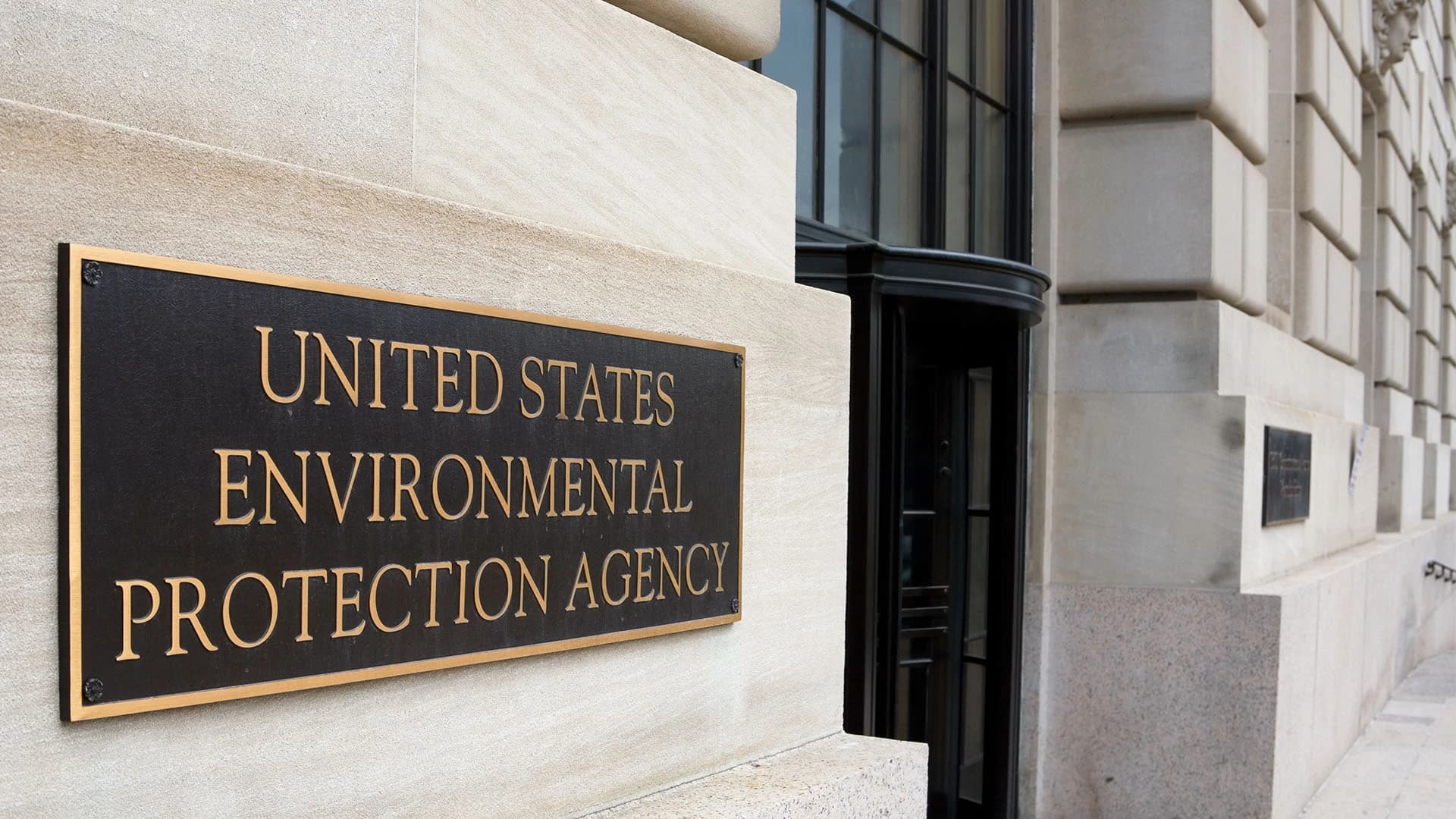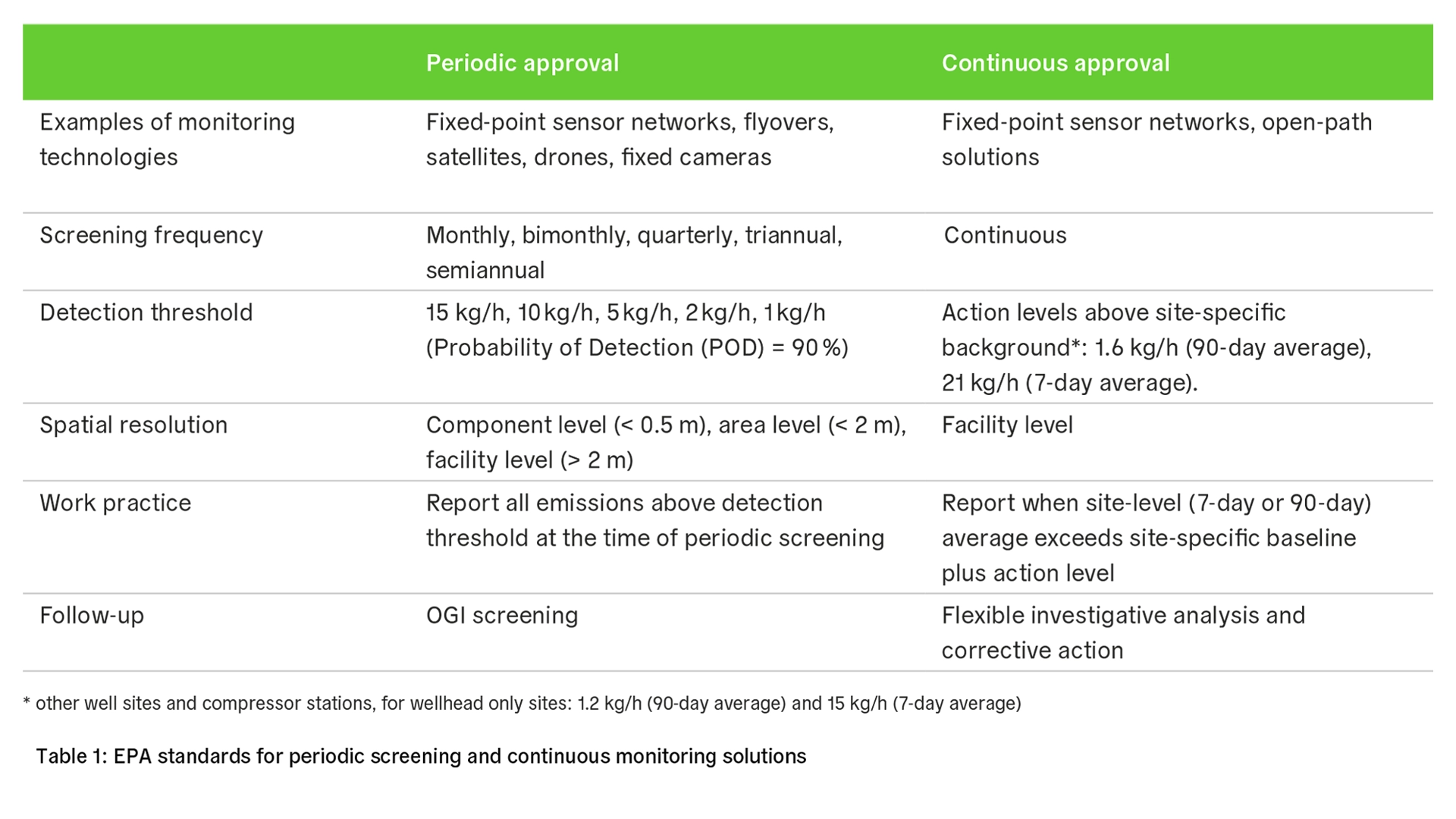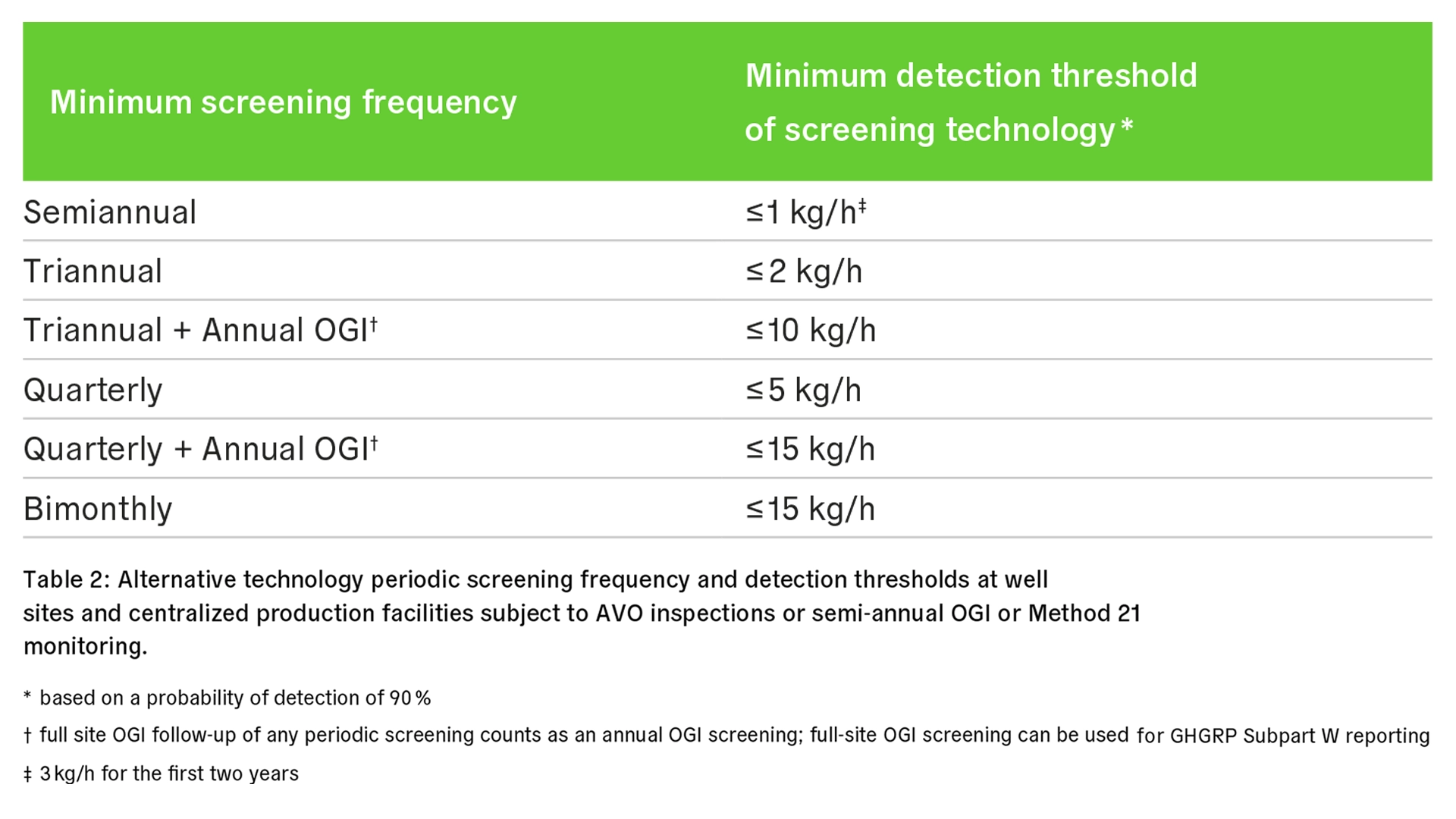19.11.2024
How to use continuous monitoring for periodic screening: why Nubo Sphere is seeking EPA approval as a periodic screening solution
This article explores the advantages of continuous monitoring when used for periodic screenings. It includes guidance on the latest EPA regulations found in NSPS OOOOb and GHGRP Subpart W with an eye to efficiently reducing emissions through periodic screenings. Operators interested in upcoming regulations of sources built, modified, or reconstructed before December 6, 2022, can expect similar standards to those found in NSPS OOOOb, but only after state laws have been created in line with the EP
- Industry Insights
- Oil & Gas

Table of contents
Executive summary
With the latest EPA regulations allowing the use of approved advanced technologies for methane emissions monitoring, Sensirion Connected Solutions is preparing an application for EPA approval of Nubo Sphere as an advanced methane detection technology, both as a continuous monitoring solution and for periodic screenings. This article focuses on Nubo Sphere’s use for periodic screenings in line with EPA regulations.
If you would like to download the article as a printable PDF, please click here: Download
There are key differences between approval for continuous monitoring and periodic screening (see Table 1). To learn more about Nubo Sphere’s use for continuous monitoring, see this article.

Future approval of Nubo Sphere for periodic screenings would make the solution usable in place of, or alongside, traditional AVO, OGI and Method 21 surveys, and subject to the same standards for surveying and reporting.
In this capacity, Nubo Sphere offers several advantages over traditional periodic screening technologies. Nubo Sphere is readily available for any periodic screening detection threshold (see Table 1 and Table 2), granting operators unparallelled flexibility in monitoring regimes that fit their operations. Furthermore, insights delivered continuously by Nubo Sphere will allow operators to prepare for surveys, thus reducing the need for follow-ups. Finally, this will help operators to continuously monitor their sites for other large release events.
This article explores these advantages. It includes guidance on the latest EPA regulations found in NSPS OOOOb and GHGRP Subpart W with an eye to efficiently reducing emissions through periodic screenings. Operators interested in upcoming regulations of sources built, modified, or reconstructed before December 6, 2022, can expect similar standards to those found in NSPS OOOOb, but only after state laws have been created in line with the EPA's EG OOOOc. For more information on EG OOOOc or any part of the latest raft of EPA regulations on methane emissions from the energy sector, read this article.
How do regulations in NSPS OOOOb and GHGRP Subpart W concern periodic screening with advanced technology?
The EPA’s latest regulations cover periodic screenings with advanced technologies in two parts: NSPS OOOOb, a revision to the New Source Performance Standards (NSPS), in Part 60, regulating infrastructure built, modified, or reconstructed after December 6, 2022; and an update to Part 98 (Mandatory Reporting of Greenhouse Gasses) GHGRP Subpart W regulating petroleum and natural gas systems.
After a brief exploration of GHGRP Subpart W, the balance of this article will focus on NSPS OOOOb regulations specifically the provisions for periodic screenings using advanced technologies such as Nubo Sphere.
Using Nubo Sphere to reduce Waste Emissions Charges under GHGRP Subpart W
The EPA has amended Subpart W of the Mandatory Greenhouse Gas Reporting Program to improve the accuracy of emissions reports. This change will require operators to submit empirical emissions data, demonstrating whether, and to what extent, they must pay a Waste Emissions Charge.
The Mandatory Greenhouse Gas Reporting Program—applicable to the oil and gas industry under Subpart W—requires operators to report emissions from facilities, calculated and reported at the level of individual well-pad or gathering-and-boosting sites, and reported as aggregated to the basin level, that have emissions exceeding 25,000 metric tons of CO2e.
The WEC applies only to facilities reporting emissions above the 25,000 mt CO2e threshold and with calculated waste emissions above industry segment-specific thresholds for methane emissions intensity. In the natural gas production segment, for example, the methane intensity threshold would be 0.2 percent of gas sent to sales from a facility.
In terms of equipment leaks or fugitive emissions, Subpart W requires either direct measurement of emissions using flow meters, calibrated bags or high-volume samplers; periodic surveys using OGI or Method 21; or the use of population emission factors. Where periodic surveys are used, this rule assumes emissions durations based on the date of those periodic surveys in lieu of empirical information to the contrary. Emissions are then estimated using leaker emission factors, which may yield estimates of emissions larger than actual emissions, thus potentially driving WEC charges higher.
In contrast, where “other large emission events” are detected by the EPA, facilities or third parties approved through the NSPS OOOOb Super Emitter Program, the EPA has determined that continuous monitoring solutions such as Nubo Sphere are well-suited to detecting when anomalous emissions begin. They may, therefore, provide data on the duration of these “other large emission events”. Using data from Nubo Sphere to time-box large emission events limits operators’ reported emissions and, consequently, potential WEC obligations by several orders of magnitude.
Note, however, that the EPA has not approved any continuous monitoring solution for site-level quantification in support of Mandatory Greenhouse Gas Reporting, or for refining emissions factors. To complete emissions estimates for GHGRP Subpart W reporting, operators will still need to complete a full site survey using Method 21 or OGI, as approved under GHGRP Subpart W. This may influence the periodic monitoring scheme operators choose to use.
How to use Nubo Sphere for periodic screening
In NSPS OOOOb, the EPA states a clear intent: “to encourage innovation resulting in meaningful emissions reductions. Whether deploying a periodic screening or continuous monitoring approach, "The EPA believes this program will allow owners and operators to leverage advanced technologies that are already available to detect methane emissions rapidly with accuracy, as well as to incorporate promising new technologies that are emerging in this rapidly evolving field." Because advanced technology like Nubo Sphere has “the potential to be more effective at finding leaks more quickly than traditional ground-based fugitive emission surveys.”, the EPA has provided an efficient pathway for operators to demonstrate that Nubo Sphere can deliver on that advantage.
Getting started with Nubo Sphere for periodic screenings
The EPA has provided directions for using advanced technology for periodic screenings that align with existing practices and reporting obligations.
First, all operators must develop fugitive emissions monitoring plans, covering all components at affected facilities. These plans should indicate the date of the initial monitoring survey and the frequency of surveys to follow, the technique and equipment used to detect fugitive emissions, repair timelines and procedures, repair verification timeframes and procedures, and all records operators will keep.
Operators have 90 days after startup or modification of components to conduct the first survey. When operators replace AVO, Method 21 of OGI surveying with Nubo Sphere surveying, they must conduct the next survey no later than they would have with those traditional methods. After the initial screening, operators can choose from several flexible options, each likely to produce comparable emissions reductions.
Choosing the right screening frequency and detection threshold
NSPS OOOOb demands more frequent monitoring at all sites, regardless of the technology used. Using Nubo Sphere for periodic screenings, it's possible to meet these obligations while also minimizing follow-up obligations.
Operators are free to choose from survey frequencies connected to detection limits by EPA guidelines (see Table 1 and Table 2). Sensirion Connected Solutions is seeking approval for Nubo Sphere as periodic screening technology for all frequencies and detection thresholds. This will grant operators using Nubo Sphere the freedom to choose the monitoring regime that best fits their requirements.


This flexibility should ease the transition to periodic screening with advanced technology. Nubo Sphere is a versatile solution seeking approval at any frequency or detection threshold listed. With sensor nodes installed and operating, monthly surveying is easily attainable. Meanwhile, follow-up obligations at this surveying frequency are limited, applying only when detected emissions meet or exceed 15 kg/h when complemented with an annual OGI inspection. On the other hand, Nubo Sphere can detect leaks below 1 kg/h, leaving open the option of quarterly surveying.
Follow-up requirements
If emissions detected during a survey do exceed the threshold set for the employed surveying frequency, operators are required to investigate, repair and report on the leak.
Investigations entail follow-up surveying, either of the entire facility or the area around emitting components, depending on the resolution of the monitoring technology, with OGI or Method 21, as well as a visual inspection of all covers and closed vent systems. Operators must repair any defects according to the procedures detailed in their emissions monitoring plan. Finally, operators must maintain records of detected leaks and report them to relevant authorities.
Screening with Nubo Sphere eliminates follow-up requirements
Operators using Nubo Sphere can all but eliminate follow-obligations. Nubo Sphere provides real-time information about on-site emissions. That means that before any periodic screening, operators can bring ongoing emissions below follow-up thresholds and limit process emissions during the surveying window.
Pending approval, the surveying period will be 12 hours. Surveying will proceed after a quality check to ensure reliable and consistent measurements are taken in appropriate conditions. Valid emission rates are only calculated if the system is operated within its operating window: temperatures must be between -20° and 50° C (-4° – 122° F), absolute humidity must be between 0.7 g/m3 and 50 g/m3, wind speeds must be between 0.5 and 10 m/s (1.5 – 33 ft/s), and monitoring equipment must be working correctly with good site coverage. Nubo Sphere monitors sites continuously, leaving operators free to survey whenever conditions are suitable. See Figure 1 for an example workflow of monthly screenings with a 15 kg/h detection limit, and Figure 2 for an example workflow of quarterly screenings with a one kg/h detection limit.
Workflow: 15 kg/h monthly screenings and OGI

Does using continuous monitoring change reporting requirements?
Using Nubo Sphere for periodic monitoring creates no new reporting requirements. The EPA expects annual reports, and reporting frequency does not change with monitoring frequency. The only change to reporting requirements operators who choose to use Nubo Sphere for periodic monitoring will see is the need to include notice of this choice in their next annual report following implementation.
- Annual reports, in general, must include the following information:
- The date of each periodic screening and the date results were received
- The screening method and technology used, including spatial resolution (facility level, area level, or component level)
- Any deviations from the monitoring plan or a statement that there were none
- The results from each periodic screening during the reporting period
If surveys detect emissions above their attached thresholds, it’s also necessary to include the dates of the survey, instrument inspection and visual inspection. Reports must include each emission or defect identified during inspections, the number and type of leaking components, the date of each repair, and an identification and explanation of each delayed repair.
Notably, operators who use Nubo Sphere to prepare for periodic screenings by reducing ongoing emissions will minimize the number of follow-up surveys and the amount of information necessary in compliance reports.
Conclusion: Nubo Sphere is an efficient tool for periodic screenings
Sensirion Connected Solutions has submitted Nubo Sphere for approval as a periodic screening solution because Nubo Sphere's strengths as a continuous monitoring solution make it an efficient tool for periodic screenings. Remember: real-time insights from Nubo Sphere equip operators to reduce emissions before periodic surveys. This may seem like cheating! It is in fact exactly what emissions monitoring should do: reduce methane emissions.
By endorsing the use of advanced technologies for periodic screenings, the EPA has eased the transition from traditional monitoring techniques. Operators who rely on periodic OGI or AVO screening can instead use Nubo Sphere—and leverage the advantages of continuous monitoring to reduce follow-up obligations.
Nubo Sphere is an asset for operators aiming to detect and reduce emissions. Used in support of LDAR programs, it delivers quick detection and localization of fugitive emissions. In the case of large-release events subject to third-party super-emitter reporting, this can make the difference that prevents heavy Waste Emissions Charges and negative publicity.
With the latest EPA regulations found in GHGRP Subpart W and NSPS OOOOb, this remains important. Under GHGRP Subpart W, Nubo Sphere can time-box emissions, furnishing reports with accurate start and end times, helping operators to manage and reduce Waste Emissions Charges. The work practices found in NSPS OOOOb also make Nubo Sphere a useful tool for meeting regulatory obligations while also reducing follow-up obligations.
In summary, continuous monitoring with Nubo Sphere should allow operators to:
- Meet EPA regulations and replace regular OGI or AVO site screenings.
- Limit follow-up investigations to only those cases where site-averaged emissions exceed site-specific baselines plus action levels.
- Save on potential WEC penalties by identifying large emissions early and precisely time-boxing reported emissions.
- Avoid reputational damage by preempting third-party detection of super emitter events and subsequent publication on the EPA’s site.
- Reduce emissions to meet ESG goals and cultivate trust with stakeholders and the community.
The EPA has made the transition to using Nubo Sphere for periodic screenings easy. They have also provided work practices for continuous monitoring that ease follow-up obligations. To provide oil and gas operators with the best options for emissions monitoring, Sensirion Connected Solutions is also seeking approval of Nubo Sphere as an alternative technology for continuous monitoring. See this article to learn more.
Related Insights Blog
09.05.2025
Proactive compliance with California’s Senate Bill 1137
The California Senate Bill 1137 (SB 1137) applies to oil and gas operations located in defined health protection zones within the state. Read on to learn how this bill will affect operations, and how Nubo Sphere can help achieve ompliance—not only with respect to SB 1137 but also California’s developing methane regulations in line with the US EPA’s EG OOOOc.
19.11.2024
Continuous monitoring in light of the EPA’s OOOOb and Subpart W
Continuous methane emissions monitoring with Nubo Sphere equips oil and gas operators with year-round oversight of oil and gas assets, quick detection of fugitive methane emissions and actionable insights in support of LDAR activities. The EPA has introduced standards for using continuous monitoring aimed at reducing emissions without unduly increasing operators’ workloads. This article provides in-depth guidance to working with these regulations, focusing on work practices for continuous monito
15.05.2024
Clearing the air: how continuous monitoring supports compliance with the latest EU methane regulations
In April, the European Parliament reached a preliminary agreement with EU member states on legislation to reduce methane emissions from the energy sector. Find out what you need to know to ensure compliance and maintain operational excellence, especially when using continuous monitoring solutions such as Nubo Sphere.
